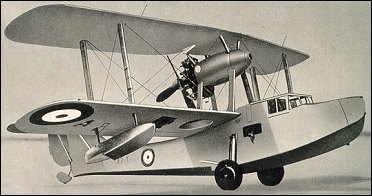|
| One of the unsung heroes of World
War II, the Supermarine Walrus
amphibian was a private venture development
of the 1922 Seagull I, and
indeed first flew as the Seagull V on 21
June 1933. A production order by the
Australian government prompted evaluation
by the Royal Navy's No. 702
Catapult Flight, which in turn led to an
initial contract for 12 Walrus Mk I aircraft
being placed by the Air Ministry
in 1935, Following further trials, during
which a Walrus was catapulted fullyloaded
from HMS Nelson, production
orders for 204 aircraft with the 474kW Pegasus II M2 radial were
placed, and the little flying-boat entered
Fleet Air Arm service in 1936.
Early in World War II Walrus amphibians
were serving aboard battleships
and cruisers of the Royal Navy all over
the world as components of No. 700
Squadron, as well as with Nos 701, 711,
712 and 714 Squadrons, their principal
duties being over-the-horizon search
for enemy shipping; they were also
employed for gunnery spotting, antisubmarine
and convoy protection
duties. A Walrus was even catapulted
from the cruiser HMS Dorsetshire to
bomb a target in Italian Somaliland on
18 November 1940.
Undoubtedly the work for which the
Walrus (affectionately known as the
Shagbat) will be best remembered
was air/sea rescue, serving in this role
with Nos 269, 275, 276, 277, 278, 281 and
282 Squadrons at stations in the United
Kingdom, and with Nos 283, 284, 292
and 294 Squadrons in the Middle East.
Called out in any weather, day or night,
Walrus air/sea rescue aircraft frequently
alighted in enemy coastal waters
to pick up ditched Allied airmen
from their dinghies, sometimes putting
down in minefields where rescue launches
could not venture. With their curious
pusher engine nacelle located between
the wings (and angled off centre),
the sight of a Walrus to a shotdown
airman meant the difference between
rescue and years in a prison
camp. The Walrus was slowly replaced
in service from 1944 onwards
by the tractor Mercury-powered Sea
Otter from the same stable, although
No. 624 Squadron was re-formed at Grottaglie in Italy in December that
year with Walrus aircraft for minespotting
duties. A total of 740 Walrus
aircraft was built, production of the
Walrus Mk I with metal-clad hull being
terminated at Supermarine after 287
had been completed; thereafter production
was switched to Saunders-Roe
who built 453 Walrus Mk II aircraft with
wooden hulls before finally ending in
January 1944.
 | A three-view drawing (592 x 892) |
| MODEL | "Walrus" Mk I |
| CREW | 3-4 |
| ENGINE | 1 x Bristol Pegasus VI, 559kW |
| WEIGHTS |
| Take-off weight | 3266 kg | 7200 lb |
| Empty weight | 2223 kg | 4901 lb |
| DIMENSIONS |
| Wingspan | 13.97 m | 46 ft 10 in |
| Length | 11.35 m | 37 ft 3 in |
| Height | 4.65 m | 15 ft 3 in |
| Wing area | 56.67 m2 | 609.99 sq ft |
| PERFORMANCE |
| Max. speed | 217 km/h | 135 mph |
| Ceiling | 5210 m | 17100 ft |
| Range | 966 km | 600 miles |
| ARMAMENT | 2-3 7.7mm machine-guns, 272kg of bombs |
| Michael Chick, e-mail, 28.10.2009 12:09 I am trying to get hold of a couple of really good photos of the Walrus. Can anyone help? Michael Chick reply | | Jack, e-mail, 21.12.2008 04:37 Were can I buy a flying model of this airplane? reply | | Chris Emms, e-mail, 17.11.2008 22:06 I recently found an alloy plate on the beach at Bembridge Isle of Wight which bears the data: Type - WALRUS, Serial number - S2 /5796. I think that this is the chassis plate from a flying boat but I can not trace the chassis number for its history, Can you help? reply | | walter moll, e-mail, 02.11.2007 16:38 Good day
I am the chairman of the Friends of the SAAF Musuem and we have in our possesion of the props of the mentioned aircraft. It would be appreciated if you have details of the hub...
Regards
Wally Moll reply | |
| | Harry, e-mail, 22.09.2007 02:40 Am in process of building a flying scale model just on 8 foot span would appreciate any info re fine details such as stensils etc.all this with a view of placing the model in malta's aviation museum. Mny thanks reply | | David Erickson, e-mail, 06.12.2006 21:13 Did the walrus have flaps on the bottom wing were they split like the tomahawks? reply | | John West, e-mail, 18.01.2007 07:49 I find this aircraft an appealing and handsome machine. The one at Yeoville turned me on to build a RC model which is just now being "kitted up" as my next build. The major problem is the location of the engine and its impact on engine (propelor) size but that will get worked out. reply |
|
Do you have any comments?
|
| 
COMPANY
PROFILE
All the World's Rotorcraft
|







